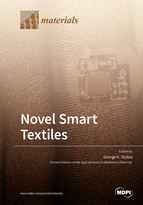Novel Smart Textiles
A special issue of Materials (ISSN 1996-1944). This special issue belongs to the section "Smart Materials".
Deadline for manuscript submissions: closed (30 September 2019) | Viewed by 57214
Special Issue Editor
Interests: smart textile materials; technical and performance materials; filtration; nanotextiles; wearable sensors and devices; textile mechanics; design/technology; intelligent manufacturing; robotics and AI
Special Issues, Collections and Topics in MDPI journals
Special Issue Information
Dear Colleagues,
This is a highly focused special journal issue dedicated to novel SMART textiles which aims to promote this life-changing discipline by providing a platform for dissemination, networking, discussion, and debate. The sensing/adapting/responding, multi-functionality, low energy, small size and weight, ease of forming, and low-cost attributes of SMART Textiles and their multidisciplinary scope offer numerous end uses in medical, sports and fitness, military, fashion, automotive, aerospace, built environment, and energy industries. The quest for these new and high-value materials crosses scientific boundaries, redefines material science, design, and engineering, and finds new uses. As such, SMART textiles are particularly important to quality of life and in sustaining energy and our environment.
I invite the community to support Materials (IF 2.654) in this timely initiative by submitting new and ground-breaking papers that will constitute the roadmap of our future research.
Prof. Dr. George K. Stylios
Guest Editor
Manuscript Submission Information
Manuscripts should be submitted online at www.mdpi.com by registering and logging in to this website. Once you are registered, click here to go to the submission form. Manuscripts can be submitted until the deadline. All submissions that pass pre-check are peer-reviewed. Accepted papers will be published continuously in the journal (as soon as accepted) and will be listed together on the special issue website. Research articles, review articles as well as short communications are invited. For planned papers, a title and short abstract (about 100 words) can be sent to the Editorial Office for announcement on this website.
Submitted manuscripts should not have been published previously, nor be under consideration for publication elsewhere (except conference proceedings papers). All manuscripts are thoroughly refereed through a single-blind peer-review process. A guide for authors and other relevant information for submission of manuscripts is available on the Instructions for Authors page. Materials is an international peer-reviewed open access semimonthly journal published by MDPI.
Please visit the Instructions for Authors page before submitting a manuscript. The Article Processing Charge (APC) for publication in this open access journal is 2600 CHF (Swiss Francs). Submitted papers should be well formatted and use good English. Authors may use MDPI's English editing service prior to publication or during author revisions.
Keywords
- textile sensors
- e-textiles
- shape/colour/phase changing
- targeted delivery
- pshychotextiles
- biomimetic
- energy harvesting
- self-regulating
- multifunctionality
- nanotextiles







